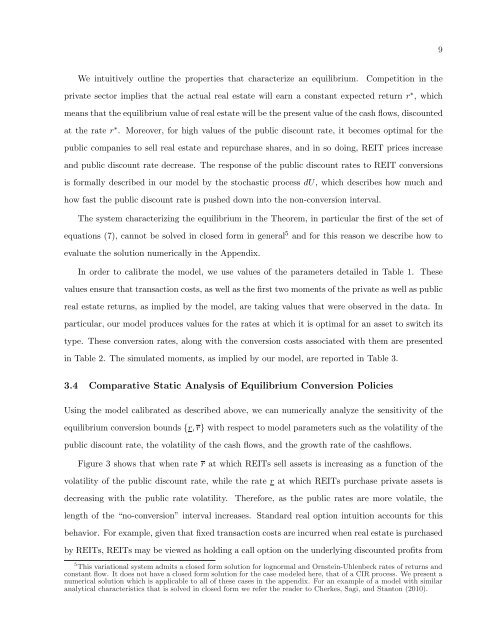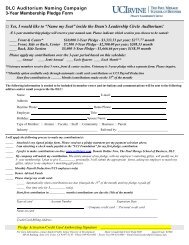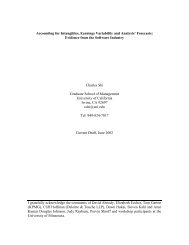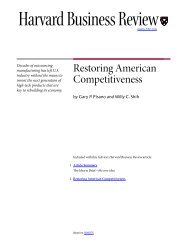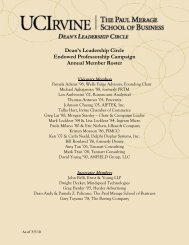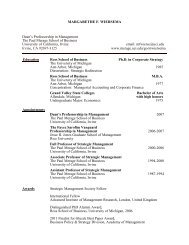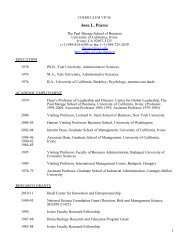View Carlson-Titman-Tiu Paper - The Paul Merage School of Business
View Carlson-Titman-Tiu Paper - The Paul Merage School of Business
View Carlson-Titman-Tiu Paper - The Paul Merage School of Business
You also want an ePaper? Increase the reach of your titles
YUMPU automatically turns print PDFs into web optimized ePapers that Google loves.
We intuitively outline the properties that characterize an equilibrium. Competition in the<br />
private sector implies that the actual real estate will earn a constant expected return r ∗ , which<br />
means that the equilibrium value <strong>of</strong> real estate will be the present value <strong>of</strong> the cash flows, discounted<br />
at the rate r ∗ . Moreover, for high values <strong>of</strong> the public discount rate, it becomes optimal for the<br />
public companies to sell real estate and repurchase shares, and in so doing, REIT prices increase<br />
and public discount rate decrease. <strong>The</strong> response <strong>of</strong> the public discount rates to REIT conversions<br />
is formally described in our model by the stochastic process dU, which describes how much and<br />
how fast the public discount rate is pushed down into the non-conversion interval.<br />
<strong>The</strong> system characterizing the equilibrium in the <strong>The</strong>orem, in particular the first <strong>of</strong> the set <strong>of</strong><br />
equations (7), cannot be solved in closed form in general 5 and for this reason we describe how to<br />
evaluate the solution numerically in the Appendix.<br />
In order to calibrate the model, we use values <strong>of</strong> the parameters detailed in Table 1. <strong>The</strong>se<br />
values ensure that transaction costs, as well as the first two moments <strong>of</strong> the private as well as public<br />
real estate returns, as implied by the model, are taking values that were observed in the data. In<br />
particular, our model produces values for the rates at which it is optimal for an asset to switch its<br />
type. <strong>The</strong>se conversion rates, along with the conversion costs associated with them are presented<br />
in Table 2. <strong>The</strong> simulated moments, as implied by our model, are reported in Table 3.<br />
3.4 Comparative Static Analysis <strong>of</strong> Equilibrium Conversion Policies<br />
Using the model calibrated as described above, we can numerically analyze the sensitivity <strong>of</strong> the<br />
equilibrium conversion bounds {r, r} with respect to model parameters such as the volatility <strong>of</strong> the<br />
public discount rate, the volatility <strong>of</strong> the cash flows, and the growth rate <strong>of</strong> the cashflows.<br />
Figure 3 shows that when rate r at which REITs sell assets is increasing as a function <strong>of</strong> the<br />
volatility <strong>of</strong> the public discount rate, while the rate r at which REITs purchase private assets is<br />
decreasing with the public rate volatility. <strong>The</strong>refore, as the public rates are more volatile, the<br />
length <strong>of</strong> the “no-conversion” interval increases. Standard real option intuition accounts for this<br />
behavior. For example, given that fixed transaction costs are incurred when real estate is purchased<br />
by REITs, REITs may be viewed as holding a call option on the underlying discounted pr<strong>of</strong>its from<br />
5 This variational system admits a closed form solution for lognormal and Ornstein-Uhlenbeck rates <strong>of</strong> returns and<br />
constant flow. It does not have a closed form solution for the case modeled here, that <strong>of</strong> a CIR process. We present a<br />
numerical solution which is applicable to all <strong>of</strong> these cases in the appendix. For an example <strong>of</strong> a model with similar<br />
analytical characteristics that is solved in closed form we refer the reader to Cherkes, Sagi, and Stanton (2010).<br />
9


